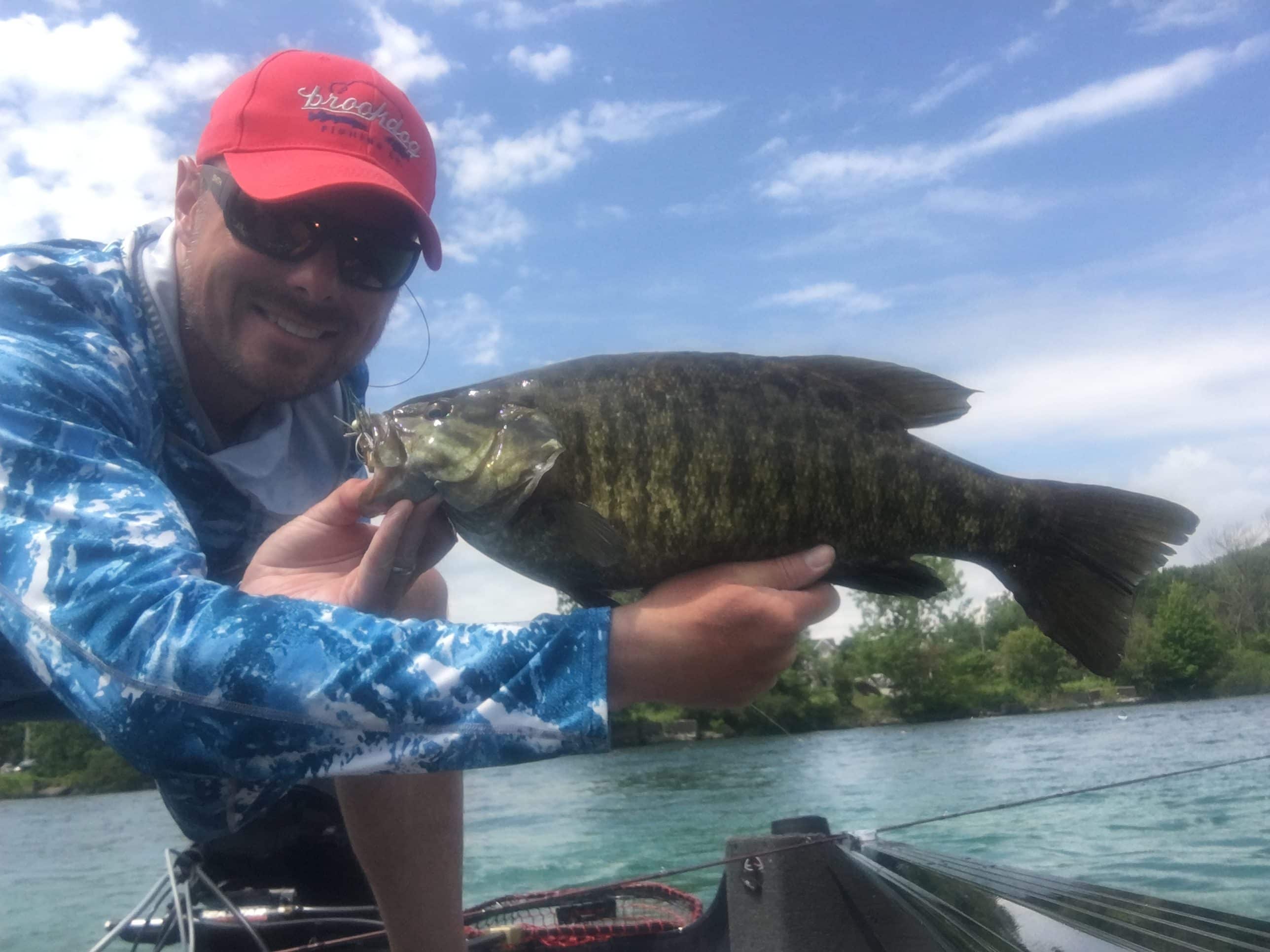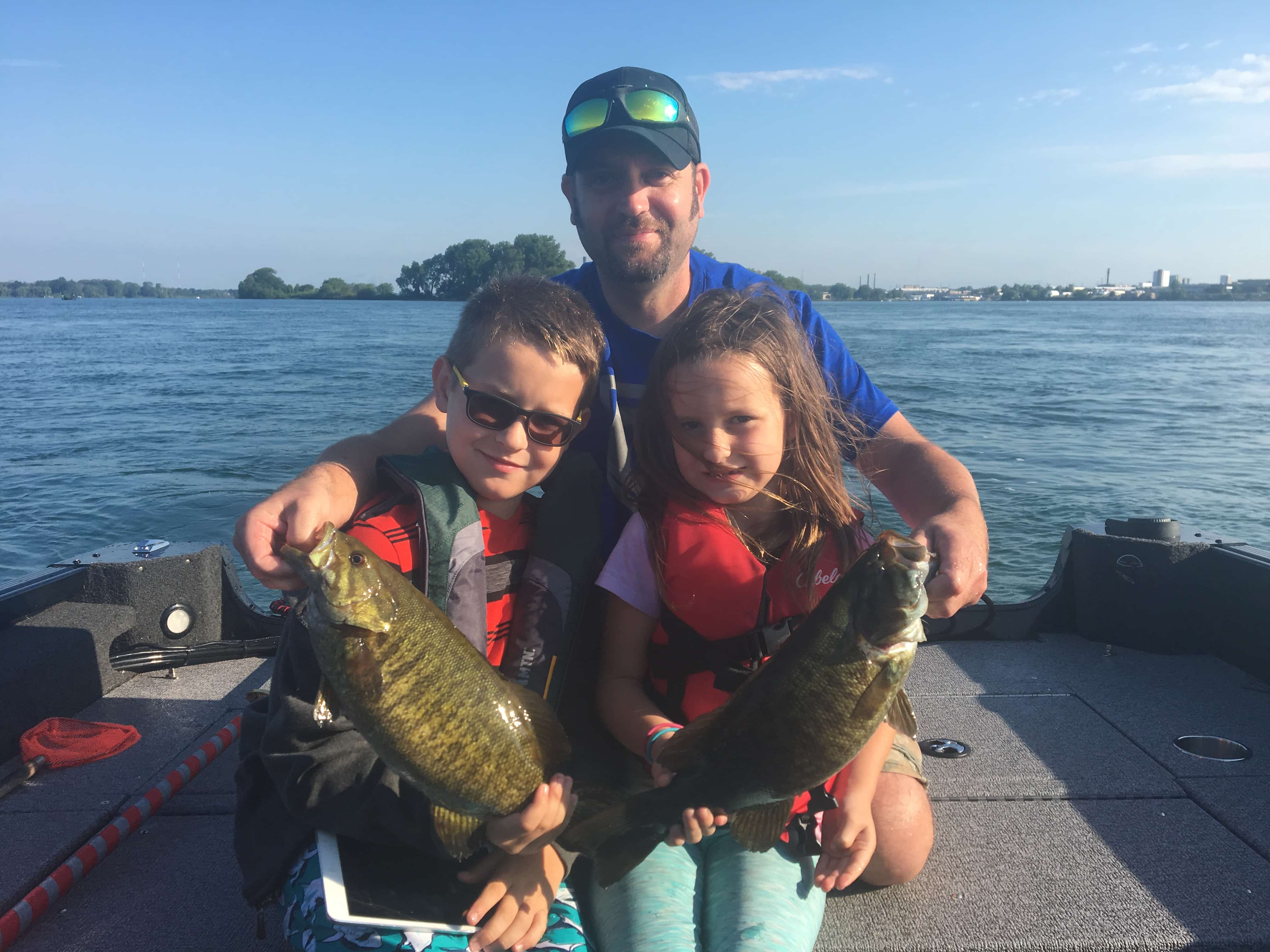Summer Fishing in Buffalo Niagara Region
Summer fishing in Buffalo Niagara can be arduous if you don’t know where to go. We wrote about this a little bit last year but have picked up our game a since then (read more water time and conflicts with that work life balance). Here are some general guidelines to help focus your summer fishing plans around here:

Bobby – Bewildered by the Size of Our Smalljaws

Smallies on the Fly – Life is Good
Angler’s Problem #1: Fish aren’t sedentary creatures – they move
Sure, a blinding statement of the obvious but understanding this is critical to fishing around the Buffalo Niagara Region. More daylight = warmer days = warmer water = increased photosynthesis = what was once a great place for fish to hang out in the spring isn’t so great anymore.
When water surface temperatures on the Niagara River and the Great Lakes start climbing it’s time to make a change. Fish start to move deep so you’ll have to do the same. This applies to all species. By now, the spawn is done and fish are filling their gullets and livin’ the laid-back summer life. In other words, they don’t want to have to work too hard to get their sustenance. All you need to do is locate those spots and bring the food to them.
Problem 1 Mitigation: Believe it or not, this isn’t terribly difficult but definitely takes time on the water
There are online resources to get you started. We’re not going to do all the work for you – but just google eastern Lake Erie fishing locations and you’ll be off to a good start. However, these resources are just that – a start. You’ll need a decent sonar and navigation system for your terminal guidance. These spots are deep areas (usually over 20 ft) and border structure. Shoals, defined weed lines, ledges, etc. all attract fish that are just trying to relax and feed. If you don’t have a water craft and a halfway decent sonar and navigation system, it’s going to be pretty difficult to get on fish.
Your presentation should be slow and deep – right through these holding areas. Think of the tackle required to accomplish this. Slow trolling deep divers. Jigging off the bottom. Dragging bait off the bottom. Stripping weighted flies and heavy, full sinking fly lines. If your sonar works, this becomes like a video game. You find the fish, present your offering, and hope. Eyes often glued to the screen. Rod and/or stripping hand at the ready. Oh yeah, I’ll state the obvious here – you need a boat to do all of this. Either buy one or book a charter.

Joe Appreciated a Little Guidance on the Big Water

My Biggest Smallie of the Season – On the Fly Nonetheless
Angler’s Problem 2: Warm water means lower oxygen levels
This is another reason why water temperatures are important. Once they climb into the low to mid 70’s, anglers should REALLY start paying attention. These temps are your indication for the summer pattern mentioned above. At this point – carp will only be on the flats early in the morning. You might find (not consistently but you can get lucky) smallies crashing bait in shallow water in the morning too. However, these are fleeting occurrences and take some serious searching to discover. Generally speaking, at these temps, fish will be deep (ref Problem 1).
The other reason water temperature is important is that the warmer it is, the lower the oxygen content. Once water temps climb into the mid to upper 70’s, it starts becoming a workout for fish. Think of it like us on the treadmill – all day long. Species like musky are particularly sensitive to high water temperatures. They are a big animal and burn O2 fast just to sustain. Leave them alone when the water gets this warm. Muskies are likely to die from exhaustion shortly after the release if you catch them at these temps. If you happen to catch one incidentally, keep the wet!

Joe is Speechless Over this Niagara River ‘jaw
The same general guidelines apply to trout. None of our inland trout fisheries are tailwaters so they warm up quick under the hot summer sun. Particularly when it doesn’t rain for a week or so. Once the inland creeks start climbing into the mid sixties, it’s time for you to leave them alone. Our inland creeks are just about there right now.
Problem 2 Mitigation: Monitor the water temperature
Your sonar should also have a thermometer. If not, buy a cheap one and take the water temperatures. Last night, the Niagara River was a little over 75 degrees. That temperature is only going to go up in the near term. Fish early morning when the water temperatures are the coolest. Fish deep water for species that live down there in the summer and are more resistant to warmer temps. Some examples are walleye, smallmouth bass, salmon, and steelhead.
If you refuse to buy a boat or don’t have the means to do so, find warm water rivers and lakes like the Allegheny River (and it’s tribs) and Chautauqua Lake where you can cast from shore or via kayak or canoe. A better option is to just hire a guide or charter captain (we know a few ). The same rule still applies on these bodies of water though – look for carp or smallies.
Anglers Problem 3: Summer is the time for pleasure boaters, jet skiers, ad kayakers
Summer Fishing in the Buffalo Niagara region is great but it comes with its challenges. Water temperatures and moving fish are one aspect but that’s not unique to this season. Every season offers a different environmental challenge that anglers have to consider. What’s unique about the summer is that us anglers aren’t the only ones out enjoying the bounty of the region. We have a lot of water around here and people love getting out and enjoying it. That comes in all forms. Pleasure boaters just drifting with the current. Jet skiers flying around at mach z. Kayakers paddling around with little situational awareness. And my personal favorite – people taking their kids tubing in fast current and/or high traffic areas.
The big take away here is that us anglers aren’t going to be the only people on the water. I can set my watch by this: at 11:00 AM on weekends, it becomes rush hour out there. Us anglers need to lift our heads up from the water every once in awhile and pay attention to what our fellow humans are doing. Often times, we take for granted the importance of general safety on the water. It’s just something we do (most of us that is). We know that we should respect people’s space and not “throw wakes” at people. We also know to check our boats for safety issues before we go out. Perhaps of upmost importance, we know the water – when we need to slow and when we can lean on the throttle. The vast majority of the pleasure boating community – well, they don’t. They are just out there having a good time with little regard to everyone else outside their boat.
Problem 3 Mitigation: Put simply – get out early and keep your head on a swivel
Pleasure boaters don’t typically get on the water until late morning – right when that first bite window starts to close. I’m usually on the water at dawn. It’s calm out there and there is little boat traffic – other than our fellow guides/charter captains. As the morning progresses, make sure to pick your head up and look around often. Pay attention to others out there and assume they aren’t paying attention to you.
Conclusion
Like we’ve said on numerous occasions, the Buffalo Niagara Region is a year-round fishery. Summer fishing in Buffalo Niagara can be a great time of year. Do a little research and invest in the equipment required to find those summer holding areas. Be responsible/respectful in maintaining a sustainable fishery by paying attention to water temps. Finally – maintain situational awareness. Do all this and you’ll be set for experiencing Buffalo Niagara Summers the best way possible – on the water.

Mike, Tristan, and Maddy – a Happy Crew

